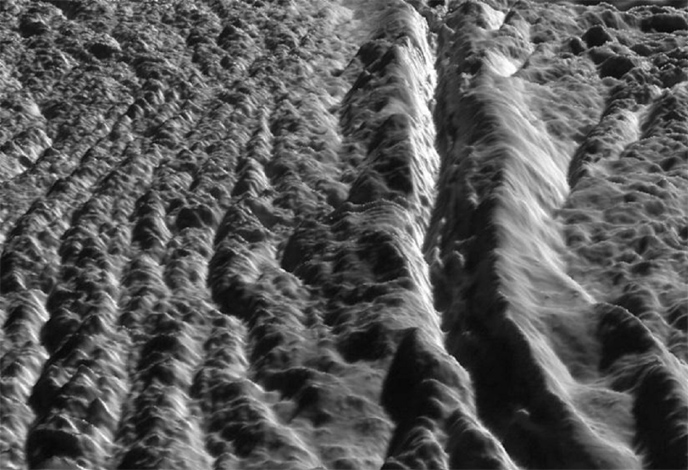|
|
|

"Tiger stripes" in Damascus Sulcus, Enceladus.
Credit: NASA/JPL/Space Science Institute
Universities Space Research Association/Lunar &
Planetary Institute.
Son of the Sky
May
05, 2010
Enceladus continues to confirm
the electrical nature of its
topography.
Saturn's moons are difficult to
categorize, let alone explain. As
previous Picture of the Day articles
point out, they vary in composition,
orbital inclination, size, and mass.
With
61 moons now identified, Saturn
appears more like a miniature Solar
System with its own influences apart
from the Sun.
Enceladus takes its name from Greek
mythology. The son of Ouranos, he
was one of the Gigantes, or
Titans, who were overthrown by Zeus
and his minions. It is perhaps an
ironic name, since it is a tiny
world only 494 kilometers in
diameter. Its gravitational
acceleration is about 10% of Earth's
1g field, so a long jump by
Carl Lewis might conceivably put
him into a low orbit, provided there
could be some way for him to survive
a temperature of -201º Celsius (and
the vacuum). Enceladus was
discovered by William Herschel in
1789.
Past Picture of the Day articles
have proposed that the serpentine
trenches, cut like swirling ribbons
across the surface, are not due to
the tidal stresses from Saturn's
gravity, but probably result from
crawling discharges of electric
current. The so-called "tiger
stripe" terrain, out of which jet
plumes of warm water vapor, are most
likely manifesting a weaker version
of the massive electrical activity
that once carved and punctured
Enceladus with magnetically
confined plasma beams.
The consensus opinion from planetary
scientists is that the tiger stripe
features are most likely caused by
"shear heating" as lateral faults in
the crust are set in motion by
Saturn. Water vapor escapes the
cracks and is dissociated by the
intense environment, whereupon it
flows along the flux tube
connections with Saturn, injecting
immense clouds of charged particles
into its plasmasphere.
It is not our contention that the
large formations on Enceladus are
being actively cut and distorted
today. It is possible that they are
the remains of the aforementioned
massive plasma discharges from
Saturn or the proximity of some
other charged object that at some
time in the past initiated the
circuit. Today, the remnant electric
fields are continuing to modify
Enceladus with "dark mode"
discharges, but the effect is less
dramatic.
Electric arcs can produce braided
rope-like trenches when plasma
filaments move across a surface.
Gouges can be created without the
lateral surface movement required by
fracturing. Do the images
transmitted from the Cassini-Equinox
spacecraft reveal any lateral
displacement? Can fracturing
experiments in any laboratory on
Earth form the braided seams on the
surface of Enceladus?
In the image at the top of the page,
the main channel is bordered by
ridges that rise to 150 meters. The
central culvert is 250 meters deep.
These are relatively large
structures, considering the small
size of the moon. It is easiest to
get an idea of what is happening on
Enceladus by comparing it to another
moon in the Solar System: Europa.
Although the plumes on Enceladus are
comparable to another of Jupiter's
Galilean moons Io, with its
traveling "volcanic caldera," the
dual-ridge faults, the supposed
subsurface ocean of liquid water,
and the broad, smooth valleys make
it more like Io's bigger sister.
Some rilles on Europa are 70
kilometers wide and travel 3000
kilometers through the
landscape—almost 30% of its
equatorial distance. The rilles have
parallel sides and a constant width
over their length. As with Enceladus,
it was suggested by the Galileo
spacecraft's mission specialists
that tidal forces are responsible
for them. However, tides, acting on
the moon’s irregular surface, would
not be able to maintain a uniform
displacement over that distance.
Interestingly, the Europa team
referred to it as having “a surface
that looked as if it had been clawed
by a tiger with talons several
kilometers wide." Both worlds,
described in similar fashion,
demonstrate the effect of "surface
lightning" as it rips great
furrows for hundreds of kilometers,
throwing out material to either
side.
Electric currents below the surface
would have caused electromagnetic
induction heating, thus accounting
for the ice rafts on Europa. The
same phenomenon could have also
affected Enceladus, bringing about
warmer areas in and around the tiger
stripes, along with the dark current
disintegration of the ice into water
vapor.
Stephen Smith
|
|
|
|
|
|
|
|
|
YouTube video, first glimpses of Episode Two in the "Symbols of an Alien Sky"
series.
|
|
|
|
|
|
|
Three ebooks in the Universe Electric series are
now available. Consistently
praised for easily understandable text and exquisite graphics.
|
|
|
|
|
|
|
|
|
|







